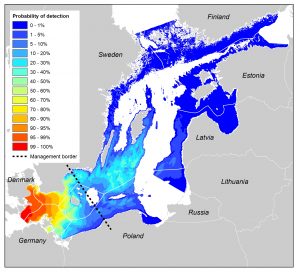The Baltic Proper harbour porpoise is critically endangered, and its distribution virtually unknown. A new research article in Biological Conservation describes the spatial and seasonal distribution of harbour porpoises in the Baltic.
Harbour porpoises are only visible when they emerge to the surface for breathing. In combination with their low numbers, this makes them difficult to study in the Baltic Sea. The current study is based on data from the SAMBAH project, where AquaBiota participated. In SAMBAH, 297 porpoise click detectors, C-PODs, were deployed throughout the Baltic Proper. Data was used to model porpoise distribution as a function of different environmental factors.
The study identified two areas with higher density of harbour porpoises during breeding season. One of these areas is exclusively used by the Baltic Sea porpoises and is believed to be the most important reproduction area for this population.

Summer distribution of harbour porpoises (May-Oct),
Reference: Carlén, I., L. Thomas, J. Carlström, M. Amundin, J. Teilmann, N. Tregenza, J. Tougaard, J. C. Koblitz, S. Sveegaard, D. Wennerberg, O. Loisa, M. Dähne, K. Brundiers, M. Kosecka, L. A. Kyhn, C. T. Ljungqvist, I. Pawliczka, R. Koza, B. Arciszewski, A. Galatius, M. Jabbusch, J. Laaksonlaita, J. Niemi, S. Lyytinen, A. Gallus, H. Benke, P. Blankett, K. E. Skóra, and A. Acevedo-Gutiérrez. 2018. Basin-scale distribution of harbour porpoises in the Baltic Sea provides basis for effective conservation actions. Biological Conservation 226:42–53.